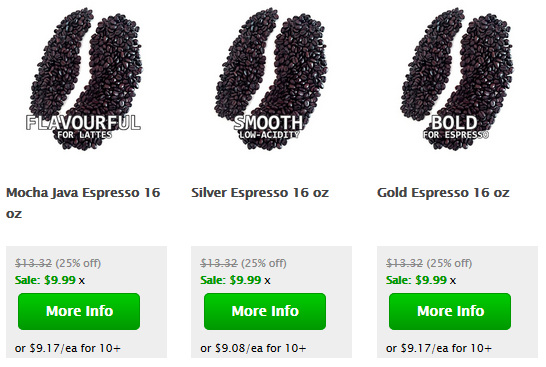The Ultimate Guide to Perfect Barista Performance
Barista Coffee Knowledge - The basics of being a Barista include increasing your overall knowledge of coffee and espresso. Baristas should be coffee aficionados who know the difference between an Ethiopian Harrar Coffee and a Central American coffee.
Baristas should also have a good knowledge of all of the stages of the coffee production process from coffee harvesting to the different methods of coffee processing. The experienced Barista even has a general understanding of the History of the Coffee Bean.
Also important is a knowledge of how coffee grading is done to determine the different types of gourmet coffee beans. The intricacies of roasting should of course be well-known to the Barista, as well as coffee grinding and the proper methods of storing coffee.
A Barista should also have a well-rounded knowledge of coffee flavors and the primary qualities of all coffees including the coffee body, aroma and acidity as well as the qualities of bitterness and sweetness of the coffee and the coffee's aftertaste, and how these qualities differ among the world's top gourmet coffees.
An experienced Barista will likely have attended an official coffee cupping (professional coffee tasting) event and learned about exploring these fine qualities of coffee and the best brewing methods to bring out these fine qualities.
Grinding Coffee a Barista Hallmark
One of the most important and most overlooked components of coffee and espresso brewing is the grinding of the coffee, which of course should be done just before brewing since the flavors and aromas will begin to degrade quickly after the grinding has been completed.
For the finest premium gourmet coffee make sure to use a burr coffee grinder rather than a blade coffee grinder, which generates too much heat and can actually re-roast the gourmet coffee beans, negatively affecting the flavor of the brewed coffee.
The best type of burr grinder to use is a conical burr grinder because it produces a consistent grind size and can deal with oily coffees. See Grinding Coffee For Espresso for more information.
Barista As Master Espresso and Coffee Brewer - Of course Baristas also need to master the art of brewing fine coffee as well as Pulling A Perfect Espresso Shot.
Some fine points of espresso brewing include making sure to always pre-warm the espresso machine portafilter as well as the demitasse that the espresso is going to flow into. A failure to do this will lower the brewing temperature and also drain the heat from the shot before it is able to be consumed.
About eight grams of roasted and ground coffee should be used for each shot of espresso. This translates to about two tablespoons of coffee.
Tamping the Espresso Into the Portafilter Basket
The process of compressing, or tamping the coffee into the portafilter should be done with a firm pressure and just a slight twist of the wrist so as to seal the puck of coffee and avoid leaving any weak spots where the high pressure water may be able to blow through without extracting flavor from the coffee.
This can lead to under-extraction and a weak and watery espresso shot.
The Art and Science of Espresso Brewing
Espresso brewing requires attention to all of the details including the Technical Specifications for Espresso. It is up to the Barista to determine the precise brewing time based on the particular coffee, grind size, and tamping pressure, and to stop the brewing at just the right time to avoid an under-extracted or over-extracted espresso shot.
Steaming and Frothing Milk for Great Espresso Drinks
Once a Barista has mastered the art of pulling a perfect espresso shot then it is time for the Barista must to learn how to make quality Espresso Drink Recipes like cappuccinos, mochas and lattes. To do this the Barista must master the skill of Steaming and Frothing Milk.
The goal of steaming and aerating milk is to create a milk with a very creamy and velvety texture that blends harmoniously with the espresso. The foam that is created should be very tasty and fine-bubbled so that it may be poured and shaped.
Barista As People Person - Most importantly the Barista needs to be a “people person” who greets customers with a smile and makes them feel welcome, giving them a wonderful coffee shop experience so they come back over and over again.
Personal Barista Hygiene - Baristas need to pay extra-careful attention to their hygiene not just to impress customers but also for food safety reasons.
Make sure you do not wear any perfume or cologne because this can overtake the fine aromas of the coffee and interfere with the whole coffee shop experience. Also make sure you do not smell of cigarette smoke or anything else.
Wear neat and proper clothing, nothing ripped or ragged, and nothing too odd or eclectic. Also avoid wearing too much jewelry. You're a Barista, not a Blingrista!
Wear A Friendly Smile
The nicest thing a customer appreciates is a smile because it is an immediate sign that the person helping them is willing and has a good attitude, which will make for a better coffee shop experience.
As a professional Barista you need to learn how to leave your personal life at the door when you come to work. No matter what is going on in your own personal life, work is not the time to vent or share your problems with customers or with other workers. A consistent, professional attitude will be highly appreciated in the long run.
Everyone has a bad day or a difficult customer once in a while. This is where you prove your professionalism by dealing with the situation in a manner that displays your ability to concentrate on your work and smile just like any other day, or any other customer.
Remembering Names and Previous Conversations
A valued coffee shop Barista will be able to remember names and things that customers share so that they can build up a relationship over time with regular customers. Avoid personal matters, but perhaps you will remember that they just moved to town, or they are someone who enjoys the beach very much, and so a comment about the town or the beach would be appropriate when you see them again and greet them by name.
You may want to use some personal tricks to remember names. When they tell you their name you may try to store it in your memory by associating the name with some particular characteristic of the person.
Remembering someone's name can go a long way to building up a trust and making that person feel welcome in your establishment.
No Unrequested Nicknames Please
By the way, no nicknames unless they tell you that name. For example, Jim doesn't become Jimbo or Big Jim, and Sally doesn't become Sal. Stick with their proper name as some people are sensitive about this issue.
This includes full names like Daniel, which some people want to always be called instead of Dan, even though it might seem common to you.
Going Beyond - Going the Extra Mile
If the customer has a problem or special request make sure and fulfill it and even go beyond if appropriate. For example if they ask for a napkin you might give them two or three. If they say they really like foam or whip cream give them a generous serving.
Providing the Customer with Your Name
If a customer offers you their name outside of their drink order then offer them your name as well. This helps to build a relationship and makes them feel like their efforts to share have been reciprocated.
Also go ahead and say their name when you wish them a good day, and again when you see them on the next visit. People appreciate hearing their own name and this will really help create a friendly atmosphere.
Following Up With Customers Part of Friendly Service
Once your customer has received their coffee, Espresso Drink and any other items they have ordered, make sure they have everything they need. If you are walking around the coffee shop cleaning up or doing other work and pass by a customer enjoying their coffee beverage, you might follow-up with a “How is your drink?” or “Everything good?” just to let them know you care.
This may also give the coffee shop customer a chance to let you know if everything was not okay, and thus you can make things right rather than have them leave disgruntled never to return. A little courtesy goes a long way as a Barista. One simple polite interaction and you may make a new friend for life!
Use Positive Body Language - Eye Contact Is Barista Must
Try to make eye contact right away when a customer is in line, and say hello to them. When you are taking your order it is also quite important to keep making eye contact when not busy ringing up the order or taking care of their requests.
Also be aware of your overall body language. If your hands are not busy with something then put them in a proper place like clasped together in front of you or behind your back. This signals that your full attention is going to the customer, while dangling hands signal disinterest or
Know Your Own Coffee Shop Menu - Barista Product Knowledge
This goes without saying, but a Barista should certainly know as much as possible about every single product being offered by the establishment. This may include which items have the most calories, which items meet certain dietary requirements (e.g., wheat free, vegan, etc.), and of course the costs of items (without needing to look them up).
Also be aware of all possible changes that can be made and how much a customer will be charged. Don't re-invent the wheel every time you get a special request.
All situations should be planned for including extra this, or no that. Even if a customer disagrees with the pricing of a particular change, it is unlikely to cause any difficulties if the coffee shop has a method and a plan, and clear pricing for all situations.
Consistency is key, and that way customers can make decisions about what changes they want to make and whether it is worth the cost.
Barista Knowledge of Coffee Terms
A Barista should have an understanding of all of the different terminology associated with coffee and espresso including the coffee beans and the brewing as well as the tasting and appreciation of fine coffee. See the Coffee Terms to study up.
For more tips see the How to make a Latte. Also see All About Coffee which describes everything from coffee plants and coffee cherry to the detailed characteristics of gourmet coffee beans. Also featured are coffee quotes and even a coffee quiz to test your knowledge of the revered coffee bean.
Thank You for Visiting Espresso Coffee Guide!
Buy Gourmet Coffee Beans

- ✔️ Fresh roasted to order
- ✔️ 100% high qualtiy Arabica coffee
- ✔️ Custom grind (or whole bean)
- ✔️ 1-way valve, laminate bag (for freshness)
- ✔️ Bulk discounts



Leave a Reply